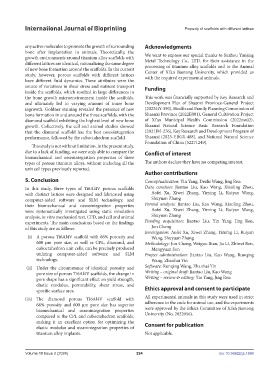Page 232 - IJB-10-2
P. 232
International Journal of Bioprinting Property of scaffolds with different lattices
any active molecules to promote the growth of surrounding Acknowledgments
bone after implantation in animals. Theoretically, the We want to express our special thanks to Suzhou Yunjing
growth environments around titanium alloy scaffolds with Metal Technology Co., LTD. for their assistance in the
different lattices are identical, rationalizing the same degree processing of titanium alloy scaffolds and to the Animal
of new bone formation around the scaffolds. In the current Center of Xi’an Jiaotong University, which provided us
study, however, porous scaffolds with different lattices with the required experimental animals.
have different fluid dynamics. These attributes were the
source of variations in shear stress and nutrient transport Funding
inside the scaffolds, which resulted in large differences in
the bone growth microenvironment inside the scaffolds, This work was financially supported by Key Research and
and ultimately led to varying amount of inner bone Development Plan of Shaanxi Province-General Project
ingrowth. Goldner staining revealed the presence of new (2022GY-390), Health and Family Planning Commission of
bone formation in and around the three scaffolds, with the Shaanxi Province (2022E001), General Cultivation Project
diamond scaffold exhibiting the highest level of new bone of Xi’an Municipal Health Commission (2022ms02),
growth. Collectively, the cell and animal studies showed Shaanxi Natural Science Basic Research Foundation
that the diamond scaffold has the best osseointegration (2021JM-276), Key Research and Development Program of
performance, followed by the cuboctahedron scaffold. Shaanxi (2023-YBGY-488), and National Natural Science
Foundation of China (52271249).
This study is not without limitation. In the present study,
due to a lack of funding, we were only able to compare the Conflict of interest
biomechanical and osseointegration properties of three
types of porous titanium alloys, without including all the The authors declare they have no competing interest.
unit cell types previously reported.
Author contributions
5. Conclusion Conceptualization: Yin Yang, Dezhi Wang, Jing Ren
In this study, three types of Ti6Al4V porous scaffolds Data curation: Jiantao Liu, Kao Wang, Xiaoling Zhou,
with distinct lattices were designed and fabricated using Aofei Xu, Xiwei Zhang, Yiming Li, Ruiyan Wang,
computer-aided software and SLM technology, and Shuyuan Zhang
their biomechanical and osseointegration properties Formal analysis: Jiantao Liu, Kao Wang, Xiaoling Zhou,
were systematically investigated using static simulation Aofei Xu, Xiwei Zhang, Yiming Li, Ruiyan Wang,
analysis, in vitro mechanical test, CFD, and cell and animal Shuyuan Zhang
experiments. The main conclusions based on the findings Funding acquisition: Jiantao Liu, Yin Yang, Jing Ren,
of this study are as follows: Jun Cheng
Investigation: Aofei Xu, Xiwei Zhang, Yiming Li, Ruiyan
(i) A porous Ti6Al4V scaffold with 66% porosity and Wang, Shuyuan Zhang
600 μm pore size, as well as CPL, diamond, and Methodology: Jun Cheng, Weiguo Bian, Jia Li, Zhiwei Ren,
cuboctahedron unit cells, can be precisely produced Mengyuan Sun
utilizing computer-aided software and SLM Project administration: Jiantao Liu, Kao Wang, Runqing
technology. Wang, Zhanhai Yin
(ii) Under the circumstance of identical porosity and Software: Runqing Wang, Zhanhai Yin
pore size of porous Ti6Al4V scaffolds, the change in Writing – original draft: Jiantao Liu, Kao Wang
pore shape has a significant effect on yield strength, Writing – review & editing: Yin Yang, Jing Ren
elastic modulus, permeability, shear stress, and
specific surface area. Ethics approval and consent to participate
(iii) The diamond porous Ti6Al4V scaffold with All experimental animals in this study were used in strict
66% porosity and 600 μm pore size has superior adherence to the code for animal use, and the experiments
biomechanical and osseointegration properties were approved by the Ethics Committee of Xi’an Jiaotong
compared to the CPL and cuboctahedron scaffolds, University (No. 2022056).
making it an excellent option for optimizing the
elastic modulus and osseointegration properties of Consent for publication
titanium alloy implants. Not applicable.
Volume 10 Issue 2 (2024) 224 doi: 10.36922/ijb.1698

